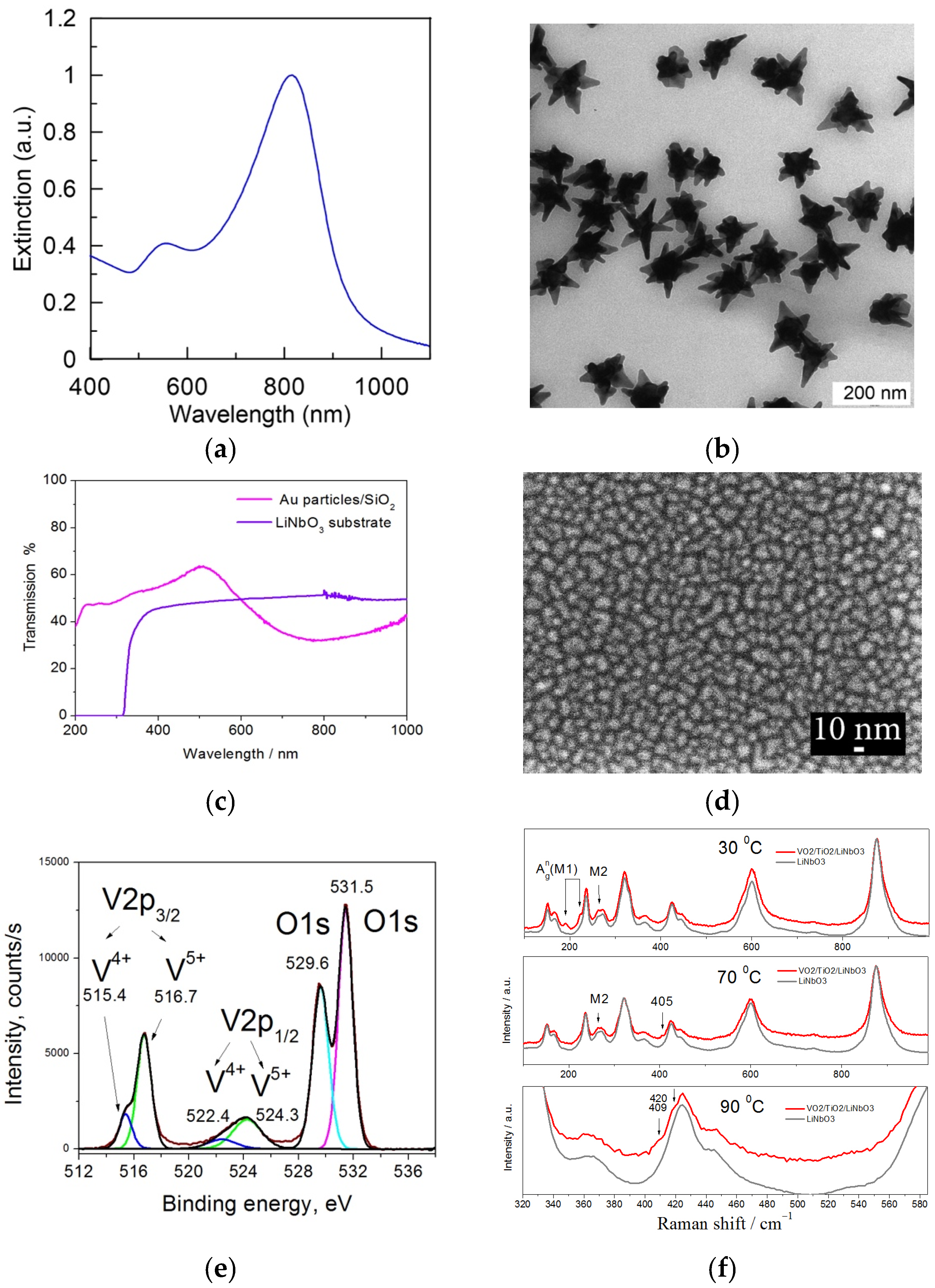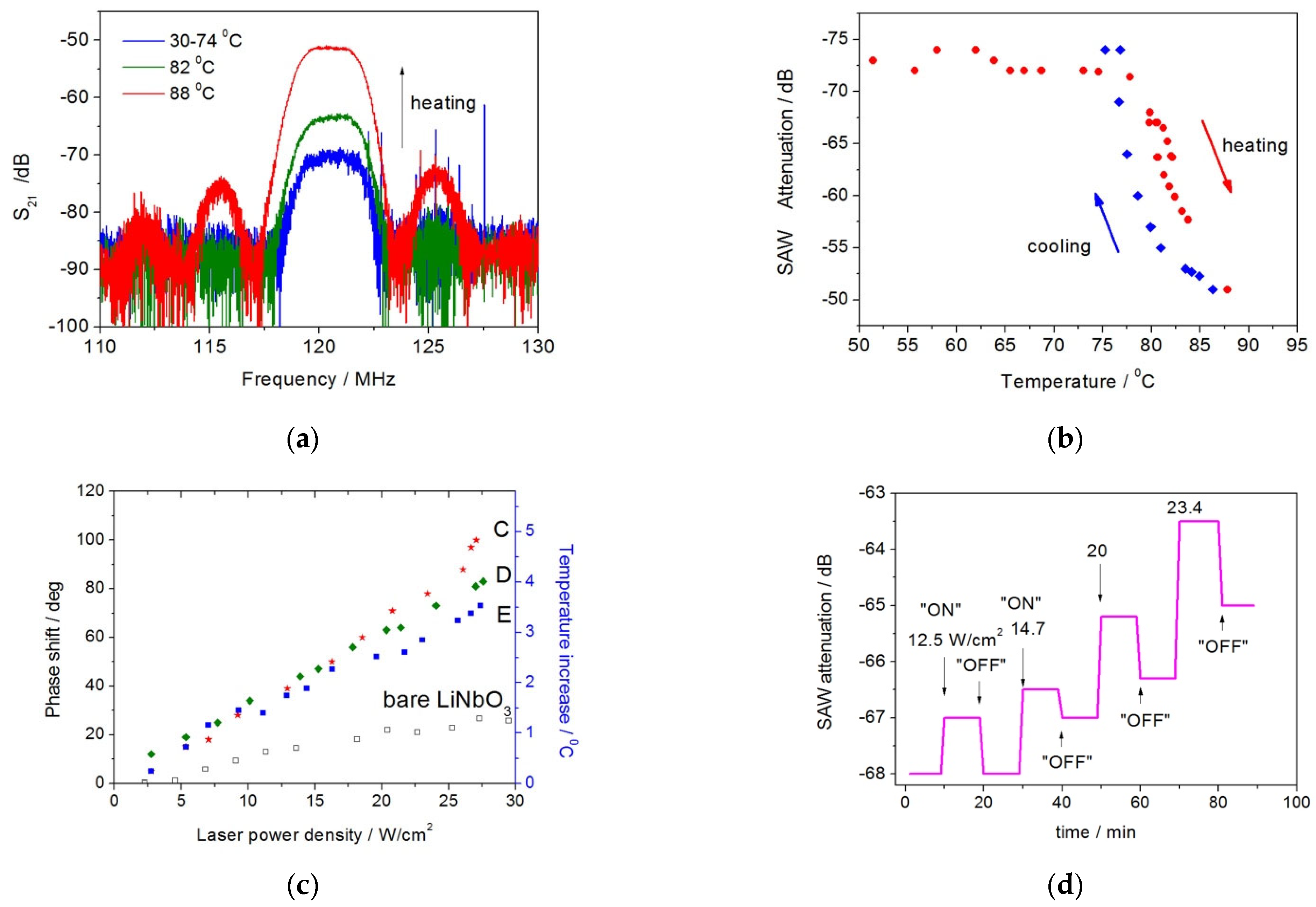Photothermal Effect and Phase Transition in VO2 Enhanced by Plasmonic Particles
Abstract
1. Introduction
2. Materials and Methods
2.1. Pulsed Laser Deposition of VO2/TiO2 on Piezoelectric LiNbO3 Substrates
2.2. Raman Spectroscopy and XPS Study of VO2 Film
2.3. Fabrication of Quiasi-Homoheneous Monolayers of Au Nanostars
2.4. PLD of a Monolayer of Au Plasmonic Coupled Nanoparticles
2.5. Characterization and Measurements
3. Results
3.1. Setup Calibration Procedure
3.2. SAW to Probe Photothermal Effect in Monolayers of Single Nanostars and Monolayer of Au Coupled Nanoparticles
3.3. SAW to Probe the Temperature Induced MIT in “Au Nanostars/VO2” System
3.4. SAW to Probe the MIT Induced by Combination of Heating and Light Exposure
3.5. Composition and Lattice Vibrations of VO2 Films on TiO2/LiNbO3 Substartes
4. Discussion
4.1. On SAW to Probe Photothermal Effect in Nanoparticles
4.2. On SAW to Probe Metal to Insulator Transition VO2
4.3. The Differences of MIT in VO2/Al2O3 and VO2/TiO2/LiNbO3 Films
5. Conclusions
Author Contributions
Funding
Institutional Review Board Statement
Informed Consent Statement
Data Availability Statement
Conflicts of Interest
References
- Cueff, S.; John, J.; Zhang, Z.; Parra, J.; Sun, J.; Orobtchouk, R.; Ramanathan, S.; Sanchis, P. VO2 nanophotonics. APL Photonics 2020, 5, 110901. [Google Scholar] [CrossRef]
- He, J.; Dong, T.; Chi, B.; Zhang, Y. Metasurfaces for terahertz wavefront modulation: A review. J. Infrared Millim. Terahertz Waves 2020, 41, 607–631. [Google Scholar] [CrossRef]
- Zhang, X.; Tian, Z.; Yue, W.; Gu, J.; Zhang, S.; Han, J.; Zhang, W. Broadband Terahertz Wave Defl ection Based on C-shape Complex Metamaterials with Phase Discontinuities. Adv. Mater. 2013, 25, 4567–4572. [Google Scholar] [CrossRef] [PubMed]
- Wang, T.; He, J.; Guo, J.; Wang, X.; Feng, S.; Kuhl, F.; Becker, M.; Polity, A.; Klar, P.J.; Zhang, Y. Thermally switchable terahertz wavefront metasurface modulators based on the insulator-to-metal transition of vanadium dioxide. Opt. Express 2019, 27, 20347–20357. [Google Scholar] [CrossRef] [PubMed]
- Liu, L.; Zhang, X.; Kenney, M.; Su, X.; Xu, N.; Ouyang, C.; Shi, Y.; Han, J.; Zhang, W.; Zhang, S. Broadband Metasurfaces with Simultaneous Control of Phase and Amplitude. Adv. Mater. 2014, 26, 5031–5036. [Google Scholar] [CrossRef] [PubMed]
- Driscoll, T.; Kim, H.T.; Chae, B.G.; Kim, B.J.; Lee, Y.W.; Jokerst, N.M.; Palit, S.; Smith, D.R.; Ventra, M.D.; Basov, D.N. Memory metamaterials. Science 2009, 325, 1518–1521. [Google Scholar] [CrossRef]
- Cai, H.; Chen, S.; Zou, C.; Huang, Q.; Liu, Y.; Hu, X.; Fu, Z.; Zhao, Y.; He, H.; Lu, Y. Multifunctional Hybrid Metasurfaces for Dynamic Tuning of Terahertz Waves. Adv. Opt. Mater. 2018, 6, 1800257. [Google Scholar] [CrossRef]
- Pan, M.; Fu, Y.; Zheng, M.; Chen, H.; Zang, Y.; Duan, H.; Li, Q.; Qiu, M.; Hu, Y. Dielectric metalens for miniaturized imaging systems: Progress and challenges. Light Sci. Appl. 2022, 11, 195. [Google Scholar] [CrossRef]
- Tian, H.W.; Shen, H.Y.; Zhang, X.G.; Li, X.; Jiang, W.X.; Cui, T.J. Terahertz Metasurfaces: Toward Multifunctional and Programmable Wave Manipulation. Front. Phys. 2020, 8, 584077. [Google Scholar] [CrossRef]
- Kaydashev, V.E.; Slavich, A.S.; Domaratskiy, I.K.; Zhukov, S.S.; Kirtaev, R.; Mylnikov, D.A.; Kutepov, M.E.; Kaidashev, E.M. Electrically reduced optical switching threshold of VO2-based THz metasurface. arXiv 2022, arXiv:2204.13427. [Google Scholar]
- Baffou, G.; Polleux, J.; Rigneault, H.; Monneret, S. Super-Heating and Micro-bubble Generation around Plasmonic Nanoparticles under cw illumination. J. Phys. Chem. C 2014, 118, 4890–4898. [Google Scholar] [CrossRef]
- Baffou, G.; Quidant, R.; Girard, C. Heat generation in plasmonic nanostructures: Influence of morphology. Appl. Phys. Lett. 2009, 94, 153109. [Google Scholar] [CrossRef]
- Govorov, A.O.; Richardson, H.H. Generating heat with metal nanoparticles. Nanotoday 2007, 2, 30–38. [Google Scholar] [CrossRef]
- Metwally, K.; Mensah, S.; Baffou, G. Isosbestic Thermoplasmonic Nanostructures. ACS Photonics 2017, 4, 1544–1551. [Google Scholar] [CrossRef]
- Galanzha, E.I.; Nedosekin, D.A.; Sarimollaoglu, M.; Orza, A.I.; Biris, A.S.; Verkhusha, V.V.; Zharov, V.P. Photoacoustic and photothermal cytometry using photoswitchable proteins and nanoparticles with ultrasharp resonances. J Biophotonics 2015, 8, 687. [Google Scholar] [CrossRef] [PubMed]
- Cui, Y.; He, Y.; Jin, Y.; Ding, F.; Yang, L.; Ye, Y.; Zhong, S.; Li, Y.; He, S. Plasmonic and metamaterial structures as electromagnetic absorbers. Laser Photonics Rev. 2014, 8, 495–520. [Google Scholar] [CrossRef]
- Molesky, S.S.; Dewalt, C.J.; Jacob, Z. High Temperature Epsilon-Near-Zero and Epsilon-Near-Pole Metamaterial Emitters for Thermophotovoltaics. Opt. Express 2013, 21, A96–A110. [Google Scholar] [CrossRef]
- Jaque, D.; Vetrone, F. Luminescence nanothermometry. Nanoscale 2012, 4, 4301. [Google Scholar] [CrossRef]
- Coppens, Z.J.; Li, W.; Walker, D.G.; Valentine, J.G. Probing and Controlling Photothermal Heat Generation in Plasmonic Nanostructures. Nano Lett. 2013, 13, 1023–1028. [Google Scholar] [CrossRef]
- Kharintsev, S.S.; Chernykh, E.A.; Shelaev, A.V.; Kazarian, S.G. Nanoscale Sensing Vitrification of 3D Confined Glassy Polymers Through Refractory Thermoplasmonics. ACS Photonics 2021, 8, 1477–1488. [Google Scholar] [CrossRef]
- Wang, Q.; Zhao, J.; Jiao, X.; Di, J.; Jiang, H. Visual and quantitative measurement of the temperature distribution of heat conduction process in glass based on digital holographic interferometry. J. Appl. Phys. 2012, 111, 093111. [Google Scholar] [CrossRef]
- Belashov, A.V.; Petrov, N.V.; Semenova, I.V. Accuracy of image-plane holographic tomography with filtered backprojection: Random and systematic errors. Appl. Opt. 2016, 55, 81–88. [Google Scholar] [CrossRef] [PubMed]
- Boyer, D.; Tamarat, P.; Maali, A.; Lounis, B.; Orrit, M. Photothermal Imaging of Nanometer-Sized Metal Particles Among Scatterers. Science 2002, 297, 1160–1163. [Google Scholar] [CrossRef] [PubMed]
- Pazos-Perez, N.; Guerrini, L.; Alvarez-Puebla, R.A. Plasmon Tunability of Gold Nanostars at the Tip Apexes. ACS Omega 2018, 3, 17173–17179. [Google Scholar] [CrossRef] [PubMed]
- Kutepov, M.E.; Kaydashev, V.E.; Karapetyan, G.Y.; Minasyan, T.A.; Chernyshev, A.V.; Abdulvakhidov, K.G.; Shevtsova, S.I.; Glazunova, E.V.; Irkha, V.A.; Kaidashev, E.M. Deep UV light sensitive Zn1-x-yMgxAlyO films with fast photoelectric response for SAW photodetectors. Smart Mater. Struct. 2019, 28, 065024. [Google Scholar] [CrossRef]
- Karapetyan, G.Y.; Kaydashev, V.E.; Zhilin, D.A.; Minasyan, T.A.; Abdulvakhidov, K.G.; Kaidashev, E.M. Use of multiple acoustic reflections to enhance SAW UV photo-detector sensitivity. Smart Mater. Struct. 2017, 26, 035029. [Google Scholar] [CrossRef]
- Sawatzky, G.A.; Antonides, E. The electronic structure and electron correlation effects studied by XPS. J. Phys. Colloq. 1976, 37, 4–117. [Google Scholar] [CrossRef]
- Demeter, M.; Neumann, M.; Reichelt, W. Mixed-valence vanadium oxides studied by XPS. Surf. Sci. 2000, 41, 454–456. [Google Scholar] [CrossRef]
- Kozakov, A.T.; Kochur, A.G.; Reznichenko, L.A.; Shilkina, L.A.; Pavlenko, A.V.; Nikolskii, A.V.; Googlev, K.A.; Smotrakov, V.G. Single-crystal rare earths manganites La1−x−yBixAyMnαO3±β(A = Ba, Pb): Crystal structure, composition, and Mn ions valence state. X-ray diffraction and XPS study. J. Electron Spectrosc. Relat. Phenom. 2013, 186, 14–24. [Google Scholar] [CrossRef]
- Kozakov, A.T.; Kochur, A.G.; Nikolskii, A.V.; Raevski, I.P.; Kubrin, S.P.; Raevskaya, S.I.; Titov, V.V.; Gusev, A.A.; Isupov, V.P.; Li, G.; et al. Valence state of B and Ta cations in the AB1/2Ta1/2O3 ceramics (A = Ca, Sr, Ba, Pb; B = Fe, Sc) from X-ray photoelectron and Mossbauer spectroscopy data. J. Electron Spectrosc. Relat. Phenom. 2020, 239, 146918. [Google Scholar] [CrossRef]
- Banger, K.K.; Yamashita, Y.; Mori, K.; Peterson, R.L.; Leedham, T.; Rickard, J.; Sirringhaus, H. Low-temperature, high-performance solution-processed metal oxide thin-film transistors formed by a “sol–gel on chip” process. Nat. Mater. 2010, 10, 45–50. [Google Scholar] [CrossRef]
- Zhou, X.; Zhao, L.; Zhen, W.; Lin, Y.; Wang, C.; Pan, T.; Li, L.; Du, G.; Lu, L.; Cao, X.; et al. Phase-Transition-Induced VO2 Thin Film IR Photodetector and Threshold Switching Selector for Optical Neural Network Applications. Adv. Electron. Mater. 2021, 7, 2001254. [Google Scholar] [CrossRef]
- Ureña-Begara, F.; Crunteanu, A.; Raskin, J. Raman and XPS characterization of vanadium oxide thin films with temperature. Appl. Surf. Sci. 2017, 403, 717–727. [Google Scholar] [CrossRef]
- Skaptsova, A.A.; Goftmana, V.V.; Galushka, V.V.; Markin, A.V.; Kochubey, V.I.; Goryacheva, I.Y. Thermosensitivity of Nanothermometer: CdSe/ZnS vs. CuInS2/ZnS. In Proceedings of the Saratov Fall Meeting 2015: Third International Symposium on Optics and Biophotonics and Seventh Finnish-Russian Photonics and Laser Symposium (PALS), Saratov, Russia, 21 April 2016; Volume 9917, p. 991712. [Google Scholar]
- Baffou, G.; Kreuzer, M.P.; Kulzer, F.; Quidant, R. Temperature mapping near plasmonic nanostructures using fluorescence polarization anisotropy. Opt. Express 2009, 17, 3291–3298. [Google Scholar] [CrossRef] [PubMed]
- Ito, A.; Kashiwagi, T. Measurement technique for determining the temperature distribution in a transparent solid using holographic interferometry. Appl. Opt. 1987, 26, 954–958. [Google Scholar] [CrossRef]
- Wixforth, A.; Scriba, J.; Wassermeier, M.; Kotthaus, J.P.; Weimann, G.; Schlapp, W. Surface acoustic waves on GaAs/AlxGa1-xAs heterostructures. Phys. Rev. B 1989, 40, 7874–7887. [Google Scholar] [CrossRef]
- Chen, B.; Kim, G.; Cho, H.J.; Ohta, H. Room Temperature Insulator-to-Metal Transition of VO2/TiO2 Epitaxial Bilayer Films Grown on M-plane Sapphire Substrates. Adv. Electron. Mater. 2022, 8, 2100687. [Google Scholar] [CrossRef]
- Muraoka, Y.; Hiroi, Z. Metal–insulator transition of VO2 thin films grown on TiO2 (001) and (110) substrates. Appl. Phys. Lett. 2002, 80, 583–585. [Google Scholar] [CrossRef]
- Ding, Z.; Cui, Y.; Wan, D.; Luo, H.; Gao, Y. High-performance thermal sensitive VO2(B) thin films prepared by sputtering with TiO2(A) buffer layer and first-principles calculations study. RSC Adv. 2017, 7, 29496–29504. [Google Scholar] [CrossRef]
- Kang, M.; Kim, I.; Kim, S.W.; Ryu, J.W.; Yeol, H. Metal-insulator transition without structural phase transition in V2O5 film. Appl. Phys. Lett. 2011, 98, 131907. [Google Scholar] [CrossRef]



Disclaimer/Publisher’s Note: The statements, opinions and data contained in all publications are solely those of the individual author(s) and contributor(s) and not of MDPI and/or the editor(s). MDPI and/or the editor(s) disclaim responsibility for any injury to people or property resulting from any ideas, methods, instructions or products referred to in the content. |
© 2023 by the authors. Licensee MDPI, Basel, Switzerland. This article is an open access article distributed under the terms and conditions of the Creative Commons Attribution (CC BY) license (https://creativecommons.org/licenses/by/4.0/).
Share and Cite
Kaydashev, V.; Khlebtsov, B.; Kutepov, M.; Nikolskiy, A.; Kozakov, A.; Konstantinov, A.; Mikheykin, A.; Karapetyan, G.; Kaidashev, E. Photothermal Effect and Phase Transition in VO2 Enhanced by Plasmonic Particles. Materials 2023, 16, 2579. https://doi.org/10.3390/ma16072579
Kaydashev V, Khlebtsov B, Kutepov M, Nikolskiy A, Kozakov A, Konstantinov A, Mikheykin A, Karapetyan G, Kaidashev E. Photothermal Effect and Phase Transition in VO2 Enhanced by Plasmonic Particles. Materials. 2023; 16(7):2579. https://doi.org/10.3390/ma16072579
Chicago/Turabian StyleKaydashev, Vladimir, Boris Khlebtsov, Maxim Kutepov, Anatoliy Nikolskiy, Alexey Kozakov, Alexey Konstantinov, Alexey Mikheykin, Gevork Karapetyan, and Evgeni Kaidashev. 2023. "Photothermal Effect and Phase Transition in VO2 Enhanced by Plasmonic Particles" Materials 16, no. 7: 2579. https://doi.org/10.3390/ma16072579
APA StyleKaydashev, V., Khlebtsov, B., Kutepov, M., Nikolskiy, A., Kozakov, A., Konstantinov, A., Mikheykin, A., Karapetyan, G., & Kaidashev, E. (2023). Photothermal Effect and Phase Transition in VO2 Enhanced by Plasmonic Particles. Materials, 16(7), 2579. https://doi.org/10.3390/ma16072579




